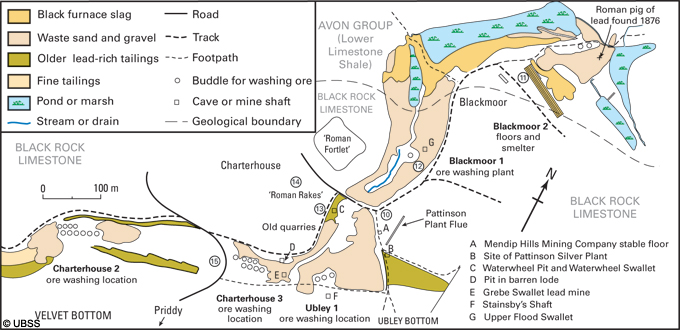
Minerals and mines
Introduction | History
of lead mining | History
of zinc mining | Lead
ore & mines
Zinc ore & mines | Iron
ore, ochre & mines | Coal mining
History of lead mining
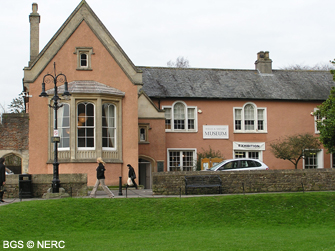
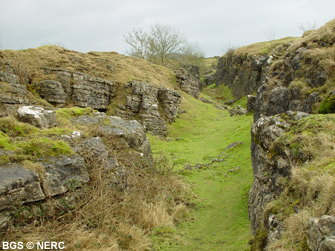
Lead mining has been taking place since the Iron Age. However, most mining took places during certain periods, particularly the Roman occupation, during the 17th and 18th centuries, and in the 19th century.
Iron Age to Roman Times
Mining on the Mendip Hills probably began in the late Iron Age. Small quantities of Iron Age pottery have been found in the rakes at Charterhouse. However, it wasn’t until Roman times that the first serious mining took place. The Romans were mining within six years of their arrival in Britain. Several large ingots of lead from the Mendips have been recovered from the region, one dated AD 49. One of these is now on display in the Wells and Mendip Museum. Some of the ingots were stamped BRIT. EX. ARG. VEB, meaning ‘British (lead) from the Veb lead-silver works’. Veb was possibly being a Roman abbreviation for Charterhouse or more likely, the Mendip mining region. It is possible that the village of Ubley may be derived from Veb-ley, a place where Romano-British miners lived. The main period of mineral extraction was the late 1st century AD.
At Charterhouse, the Romans built a small fort. Excavations here have yielded much Roman pottery including amphorae, flagons and beakers, dated to around AD 50 to AD 65. From Charterhouse, a Roman road runs south-east across the top of Mendip to link up with the Fosse Way. Roman artifacts and settlements have also been found in the Priddy area on the southern slopes of North Hill.
Post-Roman and 17 to 18th centuries
Mining probably continued on a minor scale through the Dark Ages. In 1283, Edward I granted the Prior at Charterhouse the right to work the mines. Renewed activity took place in the 17th and 18th centuries. During this time, narrower, poorer lodes were worked in deeper mines. Several mines from this period have been discovered around Charterhouse and elsewhere. In one of the mines, the last miners used their fingers to sign their names in the mud. Henry Young and John Clark were working underground on 20th November 1753. The nature of the handwriting and the small size of finger marks suggest that some of the miners were children. However, most of the mines were probably operated by local farmers supplementing their income in the winter months.
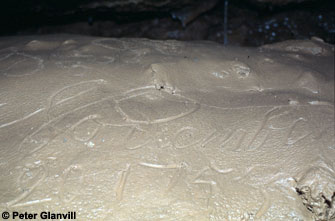
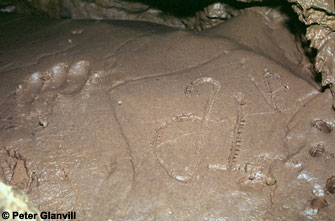
The 19th century
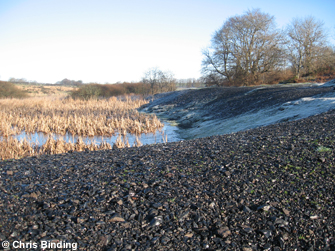
The 19th century was a period which saw Cornish mining technology used to deepen some of the mines in search of richer ore deposits. However, as the lead veins narrow with depth, this proved unsuccessful, and attention was switched to resmelting the lead-rich waste slag and slimes left over from previous medieval mining. The waste material was reworked at the Charterhouse, St Cuthberts, Chewton and Harptree mineries.
Charterhouse
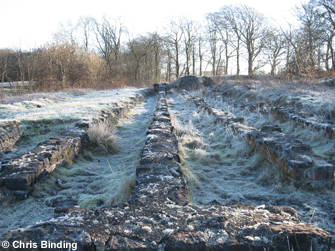
In 1844 the Mendip Hills Mining Company began work in the Charterhouse area. They company employed Cornish miners with experience and expertise of working deep tin mines. Initially, the aim was to exploit the ore at depth, which previous miners could not reach. Four deep shafts were sunk, up to 108 m deep. One of these, Stainsby’s Shaft, is the fenced off shaft near where the Cheddar to Charterhouse road crosses the valley. However, the venture proved unsuccessful, merely demonstrating that most of the rich ore lay near the surface.
To recoup their losses, they reworked the lead-rich slag and slimes from previous mining, which still contained up to 25% lead. Dressing floors to process the slag and a smelter, complete with a boiler and flues was built in Velvet Bottom, 900 m down valley from the road. Water was conducted from Long Wood via a 1800 m-long series of ‘launders’ (wooden troughs), and directed into ‘buddles’ for washing the ore. A tramroad 600 m long was built to connect the slag tips with the dressing floors. A second dressing floor was built 200 m down valley from the road embankment.
This proved successful. In 1849, a larger area of slag-rich ground was leased in the upper part of the valley around Blackmoor and Ubley Warren, close to the car park. Some of the slimes here yielded up to 57% lead! Three dressing floors and a smelter were built here.
It was at this time that the large reservoir at the upper end of Blackmoor was constructed. By 1853 over 300 people were working at the site and tens of tons of lead were being produced each month. However, the business was in trouble. Heavy expenditure, embezzlement and the costs of buying up a local farm whose land had been poisoned by the lead-rich fumes from the smelter led to the shareholders having to bail the company out. A few prosperous years followed, but by 1878, a fall in the price of lead led to a cessation of smelting, and the site was finally abandoned in 1885.
St Cuthbert's Minery
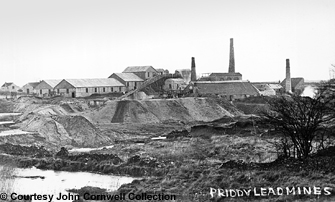
In 1862, five furnaces were erected at the St Cuthbert's Minery to smelt the old lead-rich slag left over from earlier mining, employing about 40 men, but closed in 1869. The plant reopened in 1875, when it became more profitable to ‘dress’ the slag and sell it to lead smelters in Bristol. The site was bought by Mr Theobold in 1890, but despite investment by him and a new syndicate in 1897, fluctuations in the price of lead caused the mine to shut on several occasions, finally closing in May 1908.
The Chewton Minery
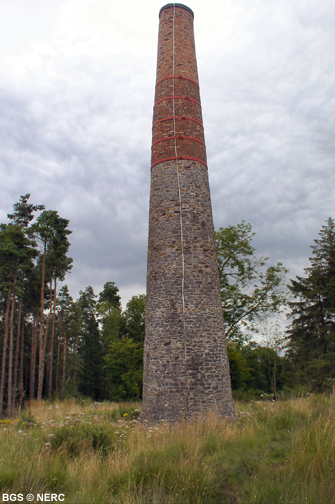
The Chewton mines are first mentioned in 1541 though they had probably been in existence before then. The medieval works were never really profitable until Cornish miners, notably Nicholas Ennor, introduced new technology in the mid 18th century and started resmelting the old lead-rich spoil, known locally as ‘slimes’. However, the requirement for water led to a series of disputes with the owners of the neighbouring St Cuthbert’s Minery. The works were never really very successful, and in 1881, the smelter was abandoned and the lead-rich slimes sold to a smelter in Bristol. However, by 1883, this venture failed and the mine was finally abandoned.
Harptree
In 1867 by a group of Cornish engineers came to revitalise the old worked out lead mines and to re-smelt the old slag heaps. They set up the East Harptree Lead Works Company in 1867, but the venture closed in 1875. The earthworks of the mine buildings, the furnace, flues and reservoirs can still be seen, but all the other buildings were demolished in 1876 except Smitham Chimney. This fell into disrepair but was restored by the Mendip Society in the early 1970s and is now the last old lead-smelting chimney still standing on Mendip.
- Home
- Overview maps
- Locality
areas
- Cheddar Gorge
- Charterhouse
- Blackdown
- Burrington Combe
- Shipham & Rowberrow
- Crook Peak & Axbridge
- Banwell to Churchill
- Priddy
- Harptree & Smitham Hill
- Draycott & Westbury-sub-Mendip
- Wookey Hole & Ebbor Gorge
- Wells
- Great Elm & Vallis Vale
- Mells & the Wadbury Valley
- The Vobster area
- The Whatley area
- Torr Works & Asham Wood
- Beacon Hill
- Stoke St Michael & Oakhill
- Holwell & Nunney
- Shepton Mallet & Maesbury
- Gurney Slade & Emborough
- The Nettlebridge valley
- Geology
- Minerals and mines
- Quarrying
- Caves and karst
- Biodiversity
- Detailed site information
- Acknowledgements
- External links
- Search
- Site map
